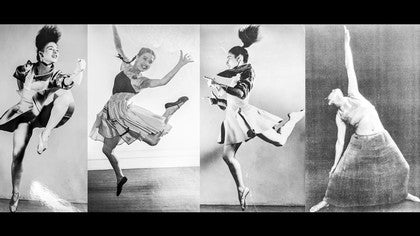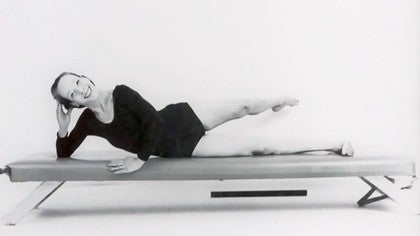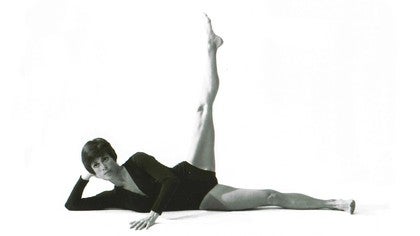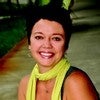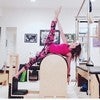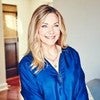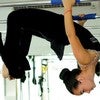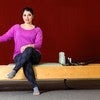Description
When Eve first moved to New York City, she joined the Hanya Holm Company. She later started her own company, Eve Gentry Dancers and also worked with the New Dance Group. While she was dancing, she suffered persistent back and knee issues so she began to study with Joseph Pilates. In 1955, Eve had a radical mastectomy which removed her pectoral muscle along with her breast. She went to Joseph Pilates and he helped her recuperate and she was able to do the more advanced exercises after just one year.
In 1968, she moved to Santa Fe, New Mexico where she opened her studio and began her journey as a healer. She taught her students to understand the concepts and principles of the movements instead of just learning the exercise. One of the many methods she created was Gentry Work, which helped her many clients who were injured.
You can learn more about Eve Gentry from her Timeline.
A derivative work based on a 1991 copyright video of the Physical Mind Institute, with the permission of Joan Breibart
The New Dance Group /Tenant of the Street footage provided by Mary Anne Santos Newhall, June 1993, NYC La Guardia High School
Photos courtesy of Mary Anne Santos Newhall, Bruce Gentry and Michele Larsson
Eve's portrait (1989) courtesy of Santa Fe Living Treasures ,Photography by Joanne Rijnes, 1989
Eve's promotional photos courtesy of Marshall Brooks, 1944
Video footage of Eve working with Joe provided by Michele Larsson and Core Dynamics Pilates
A special thanks to curator for Eve Gentry, Michele Larsson
About This Video
Transcript
Read Full Transcript
Pilates is, is not just a series of exercises. [inaudible] is a concept. It's a philosophy. No, you can learn every exercise on every piece of equipment and you don't know Pilates. So don't think that just because you know the exercises or can teach an exercise that that is belies, it is not [inaudible] is a concept. So learn and understand the concept. So you teach the concept. I, we teach concepts.
Eve gentry was born in 1909 in San Bernardino, California. She was born Henrietta Green Hood. She was the youngest of five children. And about when she was a young teenager, or maybe a little earlier, she started to take dance lessons and just loved it. And when she graduated from high school, she moved up to the bay area and Eve got a job working in Palo Alto at the community theater where she taught dance help, choreograph for a little community shows, et cetera. Her older brother, David Green Hood, was a poet and he married Helen Gentry who had a younger brother, Bruce Gentry. Bruce Gentry was a photographer and they started dating and they became an item in 1936 or they're about the gentry press moved to New York City and her brother said, look, I know a choreographer Hanya Holm So the next day she goes and she auditions for Honda and discovers that she's in the Hanya Holm Dance Company.
I believe she does some toured with Hanya home for six years. And of course in that time World War II happened and Bruce enlisted, they got married at some point during that time eve changed her name from Henrietta Green Hood to Eve gentry. Back in those days you just got on a bus or a train and you went to the next place and they would do a demonstration in the school and then they would do a little performance and maybe that night they would do a performance in the community center and then they get back on the bus and they would go to the next little town. It was hard on you physically. And so she was injured and she had been told by doctors that she needed to have some sort of medical procedure and that she perhaps would not be able to dance anymore. Definitely. I found Joe [inaudible] through a couple of dances and when I walked into the studio on, uh, on eighth avenue, between 55th and 56th street in New York and thought all this equipment and stuff then, and uh, uh, very strange, no, met Joe in Clara.
And Joe looked at me and I could feel he was X-raying me.
My husband was a photographer. There was a man coming to the studio who worked in one of the hospitals. He said, we've got to show this to the board of directors, the trustees at the hospital, they'll never believe it. So Joe said we're going to do the same exercises in the nude because they won't believe it. And they were, they excited and they said, right away you can do so much for our patients. It was just tremendously exciting spirit.
They found out that Joe was not a registered physiotherapists and the whole thing flat
She had a high chair made out of metal, a Wunda chair, a spine corrector. He had a reformer made for her and Joe's old fashioned folding mat. I came to Santa Fe in the September of 1968 I have never felt that any one place was going to be my home for the rest of my life as I do in [inaudible]. When she got to Santa Fe, she took these young girls, teenage girls, and she would bring them to her studio in Santa Fe or Pilati studio, which was underneath her garage.
It was just a cinderblock garage, I guess, you know, just funky tools around and the springs hanging off the wall. And I think she just had one reformer there and then the barrel thing. So it was very, very minimal equipment. If we had several people there, they would just sort of rotate between the
Something about the clarity of movement or something had something to do with the push with all the push was gone. It changed my concept of myself and my life. I found I was doing the polarities work differently. I was doing a slower, much more relaxed. I found I was moving in a way that I'd never moved to.
I was thinking in a way I can not. I began to do my technique did.
The types of things would be a whiplash injury from an auto accident where I had already determined there was nothing broken, there was no spinal injury. They simply needed to be helped, help in a more healing environment than just letting them get better on their own. There would be people try to Gillian things already, you know, aspirin, Tylenol, anti-inflammatories, narcotic pain, medications, shots and injections of Cortisone, even surgeries
Consequently, a short term problem becomes a lifelong problem. Then when I met Eve, uh, she wonderfully mentioned the fact, no, no, no, there are lots of things you can do to move your body and regain a mobility and function.
It was more like exercise for people who were already okay. She wanted to create something that really had all of her therapeutic ideas in it. Not just the exercise, but I mean, you can tell when you read this, this is for people who are really hurting and can just barely just do the no circle. So you could really see for this what the people would do when they'd come to the studio. And I think probably she check off the ones that she wanted people to emphasize or what have you at the time or if, you know, she really wanted her to, to them to do that, but maybe skip that or whatever, you know, she would just sort of adjust her thing for that. So that's how that book came about.
Eve was a very wonderful teacher because she would first tell you what she wanted you to do and then she would demonstrate what she wanted you to do. Um, and then when you did it, she would correct you but nicely. And if things hurt, she always said, don't do it. I'll give you another way to exercise that part of your body. So all of these little things she just added into your workout. So if you needed it, you did what she called Gentry, which was very separate from Gelato, so it wasn't pedantic or if you didn't need it.
You did put lattes when she taught how fast, I think it was her first workshop in Santa Fe when we were starting to do a training program and people came from different parts of state and say, it's an, I was involved in that workshop. She gave a demonstration of how she put pillows underneath people's bodies when they were lying down. So she was on the Cadillac putting pillows everywhere underneath person, shoulder on Darnell bow under a knee. This person's right. Shoulders forward. Why would she put a pillow under her right shoulder if it's forward. It's just going to make it go farther forward.
I mean this was I thinking in my head, but I mean I was very respectful. I thought there must be some into this. And of course years later down the line, when I had my own experience as a teacher, I realized exactly why, but that proprioceptive sense of having a pillow under there allows the client to drop into the pillow and open up that area that's maybe pulled forward forward for pain or whatever reason. But I remember from that workshop it was mostly for people in pain and she felt it was that they, they needed to feel totally comfortable lying down that there shouldn't be any place in their body. Whether it was a little build up of tension because it was wonderful. I remember I'm not, I'm on a video doing full roll up and I remember being a little nervous, my little outfit and Eve had another full wonderful image of people who you try to get them to move their neck, you know, and they're just really holding on to it.
And do you remember that there was a paintbrush way, way up on the ceiling and I'm going to paint a little stripe like forward and back on. That's a pelvis passage as you could get. And if I had to have a nickname for what eve did with people with pain, I would say learning to let go. All I did to ice, that Japanese paper making a low stroke on the feeling of vertical stuff. And I think the feedback that she would say over and over to students was, how does a feel? Because without a connection you're just doing something. You know? I never felt she was hugely strict in in us teaching what, what she told her that we had to teach the way she told.
I never got that from her until she had a phase. Probably an environment that
And that was the beginning of the damned.
I spend a lot of time with her in her home, um, because she couldn't be in the studio for that long. At that age. I'm talking about dance and how dance was important to her. And I think that talking about her PLRs work and talking about her dance worker intertwined that for her, it was all part of this great love of dance.
I've got to walk normally. So I held onto her arm and I took steps with her and I said, take a step with me, step with your right leg now, step with your left and take a bigger step, not just to one footstep. And, and we, we managed to do that going down the, the little sidewalk next to the studio and then she would revert back into the shuffle. And, but I remember her really wanting to change that, but I don't think I could. I think neurologically everything, things are changed and it was sad to watch, uh, uh, go downhill like that after being such a vibrant
Me Not to need the teacher [inaudible]
She said she, they, they all knew they were competitive and something big was going on, but they didn't know exactly what it was. I would ask her how she saw dance as a calling at that point in life. And as a life choice, I would ask to try to understand what it took to make that great leap as a woman artist in that time. I would ask her about being an immigrant coming from an immigrant family cause I come from one, two. What was that like? What was that like to come from a an Orthodox family and make dance your religion so to speak, or your calling and your language
[inaudible] a lot of questions. So I just wanted to read one more quote, which is out of a letter that Eve had written, two friends of hers whom I don't know who they are and I don't know why she made a copy of the letter, but I got in the box of stuff I got when he passed away, but it was a quote which I just think is very appropriate for all of us. The most important thing about exercising how you do it. Remember the body is a moving object. Every part of it inside and outside is designed to move, should move it, be inhibited or stopped or misdirected.
There are sure to be trouble. Mussels do generate very quickly. We should take at least as good care of our bodies as we do our car. We think our body is the most complicated instrument we will ever own. It is also the hardiest and contrary to all appearances, the most valuable. Don't give it to a little of your time and devotion.
So I have a big feeling of encouragement about the [inaudible]. We are all we do
Pilates Legacy Project - Playlist 1: Biographies
Comments
You need to be a subscriber to post a comment.
Please Log In or Create an Account to start your free trial.
